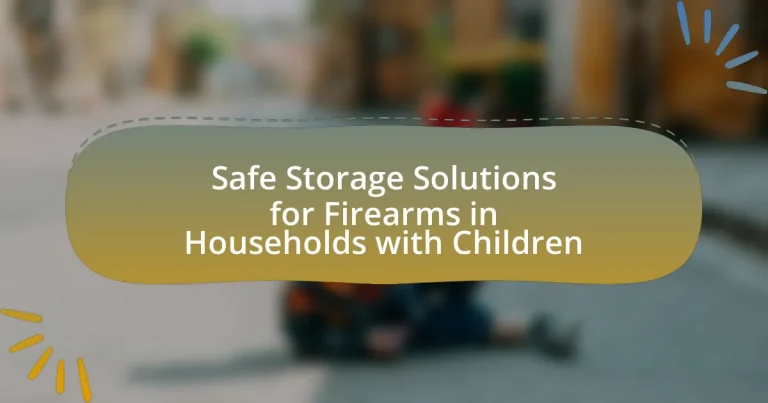The article focuses on safe storage solutions for firearms in households with children, emphasizing the importance of preventing unauthorized access and accidental shootings. It outlines various storage options, including gun safes, lockboxes, and trigger locks, and discusses the critical need for secure storage practices, supported by statistics on firearm-related injuries among children. The article also highlights best practices for maintaining firearm storage, the significance of educating children about firearm safety, and resources available for families seeking guidance on responsible gun ownership. Overall, it underscores the necessity of implementing effective storage solutions to enhance safety in homes with children.

What are Safe Storage Solutions for Firearms in Households with Children?
Safe storage solutions for firearms in households with children include using gun safes, lockboxes, and trigger locks. Gun safes provide secure, tamper-proof storage that prevents unauthorized access, while lockboxes offer portable options that can be locked and stored out of reach. Trigger locks, which prevent the firearm from being fired, add an additional layer of safety. According to the American Academy of Pediatrics, secure storage significantly reduces the risk of firearm-related injuries among children, emphasizing the importance of these safety measures.
Why is safe storage of firearms crucial in homes with children?
Safe storage of firearms is crucial in homes with children to prevent accidental shootings and unauthorized access. Statistics indicate that approximately 1,300 children die each year in the United States due to gun-related incidents, many of which occur in homes where firearms are not securely stored. Proper storage methods, such as using gun safes or lockboxes, significantly reduce the risk of children accessing firearms, thereby enhancing their safety and preventing tragic outcomes.
What statistics highlight the risks of firearms in households with children?
Households with children face significant risks associated with firearms, as statistics indicate that approximately 1 in 3 homes with children contain at least one firearm. Furthermore, research shows that children aged 0-14 are involved in nearly 1,300 unintentional firearm deaths and injuries each year in the United States. A study published in the journal “Pediatrics” found that 75% of children who were killed by firearms were shot in their own homes or in the homes of friends or relatives. Additionally, the American Academy of Pediatrics reports that the presence of a firearm in a home increases the risk of suicide among adolescents by three times. These statistics underscore the critical need for safe storage solutions to mitigate the risks of firearms in households with children.
How do children typically access firearms in the home?
Children typically access firearms in the home through unsecured storage, such as unlocked cabinets or drawers. Research indicates that approximately 1.7 million children live in homes with loaded and unlocked firearms, increasing the risk of accidental shootings. A study published in the journal “Pediatrics” found that 43% of gun-owning households with children do not store firearms safely, highlighting the prevalence of inadequate storage practices.
What types of safe storage solutions are available for firearms?
Safe storage solutions for firearms include gun safes, lockboxes, trigger locks, and cable locks. Gun safes provide secure, locked storage that is resistant to unauthorized access and can accommodate multiple firearms. Lockboxes offer portable and secure storage options, often with combination or key locks, suitable for handguns. Trigger locks prevent the firearm from being fired by locking the trigger mechanism, while cable locks secure the firearm by threading a cable through the action, rendering it inoperable. These methods are essential for preventing access by children and ensuring responsible firearm ownership.
What are the differences between gun safes, lock boxes, and trigger locks?
Gun safes, lock boxes, and trigger locks serve different purposes in firearm storage and safety. Gun safes are large, secure containers designed to store firearms and ammunition, providing protection against theft and unauthorized access, often featuring heavy-duty locks and fire resistance. Lock boxes are smaller, portable storage units that can secure a limited number of firearms or ammunition, offering basic protection but lacking the extensive security features of gun safes. Trigger locks are devices that fit over the trigger of a firearm, preventing it from being fired, thus providing a simple safety measure but not addressing overall storage security. Each option varies in terms of security level, capacity, and intended use, making them suitable for different needs in households with children.
How do biometric safes enhance firearm security?
Biometric safes enhance firearm security by providing quick and secure access through fingerprint recognition technology. This method ensures that only authorized users can access the firearm, significantly reducing the risk of unauthorized use, especially in households with children. According to a study by the National Institute of Justice, biometric safes can effectively prevent accidental discharges and unauthorized access, thereby improving overall safety in homes where firearms are stored.
What factors should be considered when choosing a storage solution?
When choosing a storage solution for firearms in households with children, safety, accessibility, and security are the primary factors to consider. Safety involves selecting a storage option that prevents unauthorized access, such as a gun safe with a reliable locking mechanism. Accessibility ensures that the firearm can be retrieved quickly in emergencies, while security focuses on protecting the firearm from theft or tampering. According to the National Shooting Sports Foundation, secure storage reduces the risk of firearm accidents and unauthorized use, highlighting the importance of these factors in safeguarding children.
How does the age of children influence storage decisions?
The age of children significantly influences storage decisions for firearms, as younger children require more secure and inaccessible storage solutions. For instance, households with toddlers or preschoolers often opt for locked cabinets or safes that are out of reach, ensuring that firearms cannot be accessed without adult supervision. In contrast, as children grow into their teenage years, families may consider different storage options, such as using biometric safes or combination locks that allow for quicker access while still maintaining safety. Research indicates that 75% of unintentional firearm deaths among children occur in homes where firearms are stored loaded and unlocked, highlighting the critical need for age-appropriate storage solutions that adapt to the developmental stages of children.
What is the importance of accessibility for responsible gun owners?
Accessibility is crucial for responsible gun owners as it ensures that firearms can be securely stored while remaining readily available for self-defense or other legitimate uses. Responsible gun ownership requires a balance between safety and accessibility; firearms must be stored in a manner that prevents unauthorized access, particularly by children, while still allowing the owner to access them quickly in emergencies. According to the National Safety Council, safe storage practices, such as using gun safes or lockboxes, significantly reduce the risk of accidental shootings and unauthorized use, thereby reinforcing the importance of accessibility in maintaining both safety and readiness.
How can families educate children about firearm safety?
Families can educate children about firearm safety by implementing structured conversations, practical demonstrations, and consistent reinforcement of safety rules. Engaging children in discussions about the dangers of firearms, explaining the importance of never touching a gun without adult supervision, and teaching them to report any found firearms to an adult are essential steps. According to the National Safety Council, children who receive proper education about firearm safety are less likely to engage in unsafe behaviors. Additionally, families can utilize educational resources such as the Eddie Eagle GunSafe Program, which provides age-appropriate materials to teach children about gun safety in a clear and engaging manner.
What age-appropriate discussions should parents have with children?
Parents should have age-appropriate discussions about firearm safety with their children. For younger children, conversations should focus on the importance of not touching firearms and informing an adult if they encounter one. As children grow older, discussions can include the responsibilities of gun ownership, the potential dangers of firearms, and the importance of safe storage practices. Research indicates that children who receive education about firearm safety are less likely to engage in risky behaviors related to guns, highlighting the necessity of these discussions.
How can parents model safe behavior around firearms?
Parents can model safe behavior around firearms by consistently demonstrating responsible handling, secure storage, and open communication about gun safety. For instance, parents should always treat firearms as if they are loaded, ensuring they follow the basic rules of gun safety, such as keeping the muzzle pointed in a safe direction and keeping their finger off the trigger until ready to shoot. Additionally, parents should store firearms in locked safes or cabinets, making them inaccessible to children, which is supported by the fact that secure storage reduces the risk of unintentional shootings by 73%. Furthermore, engaging in discussions about the dangers of firearms and the importance of safety can reinforce these behaviors, as studies show that children who receive education about gun safety are less likely to engage in risky behaviors around firearms.
What are the best practices for maintaining firearm storage solutions?
The best practices for maintaining firearm storage solutions include using secure, locked storage units, regularly inspecting the storage conditions, and ensuring that firearms are unloaded when stored. Secure storage units, such as gun safes or lockboxes, prevent unauthorized access, particularly by children, which is crucial for safety. Regular inspections help identify any wear or damage to the storage unit, ensuring it remains effective. Additionally, storing firearms unloaded reduces the risk of accidental discharge. According to the National Safety Council, proper storage can significantly decrease the likelihood of firearm-related accidents in households with children.
How often should firearm storage solutions be inspected for security?
Firearm storage solutions should be inspected for security at least once a month. Regular monthly inspections help ensure that locks, hinges, and other security features are functioning properly, reducing the risk of unauthorized access. According to the National Shooting Sports Foundation, consistent checks can identify potential vulnerabilities and maintain the integrity of the storage system, which is crucial in households with children.
What maintenance tips ensure the longevity of storage devices?
To ensure the longevity of storage devices, regularly back up data, maintain a stable environment, and perform routine checks. Regular backups protect against data loss, while a stable environment—characterized by controlled temperature and humidity—prevents physical damage. Routine checks, including monitoring for signs of wear or failure, help identify issues early. According to the National Institute of Standards and Technology, maintaining optimal conditions can extend the lifespan of storage devices significantly, often by several years.
What common mistakes should be avoided in firearm storage?
Common mistakes to avoid in firearm storage include failing to use a secure locking mechanism, storing firearms loaded, and keeping them in easily accessible locations for children. Secure locking mechanisms, such as gun safes or lockboxes, are essential to prevent unauthorized access. Statistics indicate that approximately 1.7 million children live in homes with unlocked firearms, increasing the risk of accidental shootings. Additionally, firearms should always be stored unloaded to minimize the risk of accidental discharge. Proper storage locations should be out of reach of children, ensuring that firearms are not easily accessible.
How can improper storage lead to accidents or unauthorized access?
Improper storage of firearms can lead to accidents or unauthorized access by making weapons easily accessible to children or untrained individuals. When firearms are not securely locked away or stored in a manner that prevents tampering, children may find and handle them, increasing the risk of accidental discharge. According to the National Safety Council, approximately 1,300 children die each year from unintentional firearm injuries, highlighting the critical need for secure storage practices. Additionally, unauthorized access can occur if firearms are stored in locations that are not adequately monitored, such as under beds or in unlocked cabinets, allowing intruders or unauthorized users to gain access.
What are the consequences of neglecting firearm safety in homes with children?
Neglecting firearm safety in homes with children can lead to severe consequences, including accidental shootings, injuries, or fatalities. According to the Centers for Disease Control and Prevention (CDC), in 2019, there were over 3,000 unintentional firearm deaths in the United States, with a significant portion involving children. Furthermore, a study published in the journal “Pediatrics” found that children aged 0-14 years are at a higher risk of firearm-related injuries when firearms are not securely stored. These statistics underscore the critical importance of implementing proper firearm safety measures to prevent tragic outcomes in households with children.
What resources are available for families seeking safe storage solutions?
Families seeking safe storage solutions for firearms can access various resources, including the National Shooting Sports Foundation (NSSF), which provides guidelines and educational materials on safe storage practices. Additionally, the American Academy of Pediatrics (AAP) offers recommendations for parents on securing firearms in homes with children, emphasizing the importance of using gun safes and locks. Local law enforcement agencies often conduct programs that educate families about safe storage options and may provide free or discounted locking devices. Furthermore, organizations like Everytown for Gun Safety provide online resources and toolkits aimed at promoting safe firearm storage in households with children.
Where can families find reliable information on firearm safety and storage?
Families can find reliable information on firearm safety and storage through organizations such as the National Rifle Association (NRA), the American Academy of Pediatrics (AAP), and the Centers for Disease Control and Prevention (CDC). These organizations provide comprehensive guidelines and resources on safe firearm practices, including proper storage methods to prevent unauthorized access by children. For instance, the NRA offers a variety of educational materials and safety courses, while the AAP emphasizes the importance of secure storage to reduce the risk of firearm-related injuries among children. The CDC also provides statistics and recommendations on firearm safety, reinforcing the need for responsible storage practices.
What organizations offer support and education for responsible gun ownership?
Organizations that offer support and education for responsible gun ownership include the National Rifle Association (NRA), the National Shooting Sports Foundation (NSSF), and the Everytown for Gun Safety organization. The NRA provides training programs and resources focused on safe firearm handling and storage, while the NSSF promotes safe storage practices through initiatives like Project ChildSafe, which distributes free gun locks. Everytown for Gun Safety advocates for responsible gun ownership and provides educational resources aimed at preventing gun violence, particularly in households with children. These organizations collectively contribute to enhancing awareness and practices surrounding responsible gun ownership.
What practical tips can families implement for safe firearm storage?
Families can implement several practical tips for safe firearm storage, including using gun safes, securing firearms with locks, and storing ammunition separately. Gun safes provide a secure environment that prevents unauthorized access, particularly by children. According to the National Safety Council, storing firearms in a locked safe reduces the risk of accidental shootings and unauthorized use. Additionally, using trigger locks or cable locks on firearms adds an extra layer of security. It is also essential to keep ammunition in a separate locked location to further minimize risks. Regularly educating family members about firearm safety and the importance of secure storage reinforces responsible practices.


